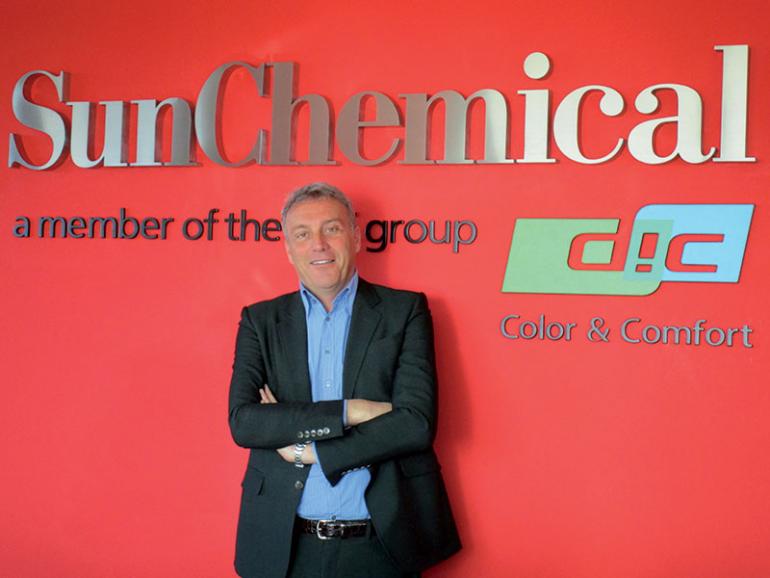Adhesives... mon amour
Sun Chemical acquires SAPICI and strengthens its position as an integrated supplier not only of inks for packaging printing, but also of adhesives for lamination. An important signal, as Fabio Deflorian points out, that testifies to the will and determination with which the multinational is building, today for tomorrow, sustainability - environmental, social and economic - at a time that is certainly not easy, not least because of increases in product and energy prices.
Stefano Lavorini

Sun Chemical, after taking over the global pigments* business BASF Colors & Effects (BCE) in 2021, is further expanding its product portfolio, finalizing in early January 2022 the acquisition of Italy’s Sapici SpA, a world-class producer of high-performance polyurethanes for coatings, flexible packaging and industrial adhesives.
The U.S. multinational, controlled by DIC Corporation, thus becomes a supplier of excellence for the packaging market: from polymer resins to pigments, from grease and liquid inks for all printing technologies to lacquers and adhesives for lamination.
With this in mind, Fabio Deflorian, CEO of the group in Italy, Austria, Saudi Arabia and the Emirates, and other geographical areas such as Hungary, Romania, Balcans and Greece does not hide his satisfaction:
«The acquisition of Sapici is a sign of great will and determination, and our American, but above all Japanese, colleagues should be credited with having believed in the value of this investment.
The future belongs to those who are open to change, in terms of organization, market approach and culture. And Sapici’s extensive portfolio of very low migration adhesives for lamination, integrated with the DIC Group’s technology, allows us to offer the flexible packaging market an unparalleled range of solutions».
In addition, Sun Chemical with Sapici aims to develop exclusive polymers for the production of inks, coatings and adhesives, able to give answers to current and future challenges in sustainability, compliance, food contact, health and safety: for example, new polyurethane products with free monomer content lower than 0.1% by weight, able to generate advantages and growth opportunities for the entire sector.
Deflorian reiterates: «This is certainly a path that allows us to further qualify our service to customers and, in particular, to those many converters who, just during the year just gone, have been able to innovate by creating new types of flexible packaging that are more sustainable, thanks to a concrete economic and human resources commitment».

Nothing is left to chance
In truth, since 2017 Sun Chemical has been marketing in Europe and the Americas under its own brand, the laminating adhesives produced by Sapici, and even more so today with the acquisition of the company’s two Italian plants, the investments in R&D and production capacity will be fully exploited.
Moreover, Sapici, in the name of transparency and fairness, will maintain its logo, identity and autonomy, also in view of the fact that its core business is the production of polymers and that its customers include important multinationals active in the same markets as Sun Chemical.
As in the past, therefore, Cristian Furiosi continues to be CEO of the Lombardy-based company, while responsibility for the business at group level rests with Mehran Yazdani, President of Global Packaging and Advanced Materials at Sun Chemical.
The intent is in fact to put in place an agile and responsive structure, with open-minded, competent people, able to improve the ways of relating with the outside world, to remain competitive in an increasingly difficult context.
The price battle will continue in 2022
Sun Chemical Italia’s 2021 budget closes with growth in value - driven by the rising cost of raw materials - but also in volume, across all product lines: water-based and solvent-based liquid inks, coatings, products for sheetfed offset printing and, also, for heatset printing (publishing, advertising) where, despite the fact that the trend remains slightly negative, Sun Chemical is increasing its market share. The problem of the indiscriminate and continuous increase in raw materials is putting a worrying strain on the market. For Fabio Deflorian, it is inevitable that further adjustments will be made in the future:
«In 2021, despite everything, taking the increase in material prices as a 100, we recovered, or rather transferred to the market, only 60% of the additional costs.
And unfortunately, this trend is continuing, forcing us into a continuous run-up, which in essence we do not expect to change before September 2022. As a result, if last year we had to increase the prices of our products (between March and November by an average of 12%), first every four months and then every three months, from January we are forced to adjust our price lists month by month».
Evidently, in cascade form, the converters have also had to deal with this difficult situation, made worse by the fact that last year’s contracts left them very little room for manoeuvre. However, supply contracts with major brand owners are usually renewed between September and December and it seems inevitable (and desirable) that safeguard clauses will be included to allow printing and converting companies to continue working economically.
Deflorian adds: «The general increase in the prices of raw materials, to which energy prices can be added, will eventually be passed on to consumers, causing the inflation rate to rise significantly, well beyond the estimates made up to now. And this can only be a cause for concern».
* Pigments for electronic displays, cosmetics, coatings, plastics, inks and specialty applications


















